2. Huang C, Wang Y, Li X, Ren L, Zhao J, Hu Y, et al. Clinical features of patients infected with 2019 novel coronavirus in Wuhan, China. Lancet. 2020; 395(10223):497–506. PMID:
31986264.

3. Kim JY, Choe PG, Oh Y, Oh KJ, Kim J, Park SJ, et al. The first case of 2019 novel coronavirus pneumonia imported into Korea from Wuhan, China: implication for infection prevention and control measures. J Korean Med Sci. 2020; 35(5):e61. PMID:
32030925.

4. Lee JY, Hong SW, Hyun M, Park JS, Lee JH, Suh YS, et al. Epidemiological and clinical characteristics of coronavirus disease 2019 in Daegu, South Korea. Int J Infect Dis. 2020; 98:462–466. PMID:
32702415.

5. Ministry of Health and Welfare. Confirmed patient status of coronavirus disease 2019 in South Korea. Updated 2021. Accessed April 15, 2017.
http://ncov.mohw.go.kr/
.
6. Kim SW, Kim SM, Kim YK, Kim JY, Lee YM, Kim BO, et al. Clinical characteristics and outcomes of COVID-19 cohort patients in Daegu metropolitan city outbreak in 2020. J Korean Med Sci. 2021; 36(1):e12. PMID:
33398946.

7. Wu Z, McGoogan JM. Characteristics of and important lessons from the coronavirus disease 2019 (COVID-19) outbreak in China: summary of a report of 72 314 cases from the Chinese Center for Disease Control and Prevention. JAMA. 2020; 323(13):1239–1242. PMID:
32091533.
8. Cascella M, Rajnik M, Cuomo A, Dulebohn SC, Di Napoli R. Features, Evaluation, and Treatment of Coronavirus (COVID-19). StatPearls. Treasure Island, FL, USA: StatPearls Publishing Copyright;2021.
9. Nicola M, Alsafi Z, Sohrabi C, Kerwan A, Al-Jabir A, Iosifidis C, et al. The socio-economic implications of the coronavirus pandemic (COVID-19): a review. Int J Surg. 2020; 78:185–193. PMID:
32305533.

10. Goodell JW. COVID-19 and finance: agendas for future research. Finance Res Lett. 2020; 35:101512.

11. Bruns DP, Kraguljac NV, Bruns TR. COVID-19: Facts, cultural considerations, and risk of stigmatization. J Transcult Nurs. 2020; 31(4):326–332. PMID:
32316872.

12. Viner RM, Russell SJ, Croker H, Packer J, Ward J, Stansfield C, et al. School closure and management practices during coronavirus outbreaks including COVID-19: a rapid systematic review. Lancet Child Adolesc Health. 2020; 4(5):397–404. PMID:
32272089.

13. Dubey S, Biswas P, Ghosh R, Chatterjee S, Dubey MJ, Chatterjee S, et al. Psychosocial impact of COVID-19. Diabetes Metab Syndr. 2020; 14(5):779–788. PMID:
32526627.

14. Wu T, Jia X, Shi H, Niu J, Yin X, Xie J, et al. Prevalence of mental health problems during the COVID-19 pandemic: a systematic review and meta-analysis. J Affect Disord. 2021; 281:91–98. PMID:
33310451.

15. Brooks SK, Webster RK, Smith LE, Woodland L, Wessely S, Greenberg N, et al. The psychological impact of quarantine and how to reduce it: rapid review of the evidence. Lancet. 2020; 395(10227):912–920. PMID:
32112714.

16. Ghosh R, Dubey MJ, Chatterjee S, Dubey S. Impact of COVID -19 on children: special focus on the psychosocial aspect. Minerva Pediatr. 2020; 72(3):226–235. PMID:
32613821.

17. Fegert JM, Vitiello B, Plener PL, Clemens V. Challenges and burden of the Coronavirus 2019 (COVID-19) pandemic for child and adolescent mental health: a narrative review to highlight clinical and research needs in the acute phase and the long return to normality. Child Adolesc Psychiatry Ment Health. 2020; 14(1):20. PMID:
32419840.

18. Guessoum SB, Lachal J, Radjack R, Carretier E, Minassian S, Benoit L, et al. Adolescent psychiatric disorders during the COVID-19 pandemic and lockdown. Psychiatry Res. 2020; 291:113264. PMID:
32622172.

19. Wilson N, Turner-Halliday F, Minnis H. Escaping the inescapable: Risk of mental health disorder, somatic symptoms and resilience in Palestinian refugee children. Transcult Psychiatry. 2021; 58(2):307–320. PMID:
33522455.

20. Zhao Y, Guo Y, Xiao Y, Zhu R, Sun W, Huang W, et al. The effects of online homeschooling on children, parents, and teachers of grades 1-9 during the COVID-19 pandemic. Med Sci Monit. 2020; 26:e925591. PMID:
32917849.

21. Lin MP. Prevalence of internet addiction during the COVID-19 outbreak and its risk factors among junior high school students in Taiwan. Int J Environ Res Public Health. 2020; 17(22):8547.

22. Cost KT, Crosbie J, Anagnostou E, Birken CS, Charach A, Monga S, et al. Mostly worse, occasionally better: impact of COVID-19 pandemic on the mental health of Canadian children and adolescents. Eur Child Adolesc Psychiatry. Forthcoming. 2021; DOI:
10.1007/s00787-021-01744-3.

23. O'Donohue K, Berger E, McLean L, Carroll M. Psychological outcomes for young adults after disastrous events: a mixed-methods scoping review. Soc Sci Med. 2021; 276:113851. PMID:
33812159.
24. Makwana N. Disaster and its impact on mental health: a narrative review. J Family Med Prim Care. 2019; 8(10):3090–3095. PMID:
31742125.

25. Newnham EA, Dzidic PL, Mergelsberg EL, Guragain B, Chan EY, Kim Y, et al. The Asia Pacific Disaster Mental Health Network: setting a mental health agenda for the region. Int J Environ Res Public Health. 2020; 17(17):6144.

26. Daegu Metropolitan Office of Education. A Report of COVID- 19 Related Student and Teacher Disaster Mental Health Assessment (Publication No. 2020-157). Daegu, Korea: Daegu Metropolitan Office of Education;2021.
27. Spitzer RL, Kroenke K, Williams JB, Group PH, Group PH. Validation and utility of a self-report version of PRIME-MD: the PHQ primary care study. Primary Care Evaluation of Mental Disorders. Patient Health Questionnaire. JAMA. 1999; 282(18):1737–1744. PMID:
10568646.
28. Park SJ, Choi HR, Choi JH, Kim KW, Hong JP. Reliability and validity of the Korean version of the Patient Health Questionnaire-9 (PHQ-9). Anxiety Mood. 2010; 6(2):119–124.
29. Spitzer RL, Kroenke K, Williams JB, Löwe B. A brief measure for assessing generalized anxiety disorder: the GAD-7. Arch Intern Med. 2006; 166(10):1092–1097. PMID:
16717171.
30. Kroenke K, Spitzer RL, Williams JB, Monahan PO, Löwe B. Anxiety disorders in primary care: prevalence, impairment, comorbidity, and detection. Ann Intern Med. 2007; 146(5):317–325. PMID:
17339617.

31. Plummer F, Manea L, Trepel D, McMillan D. Screening for anxiety disorders with the GAD-7 and GAD-2: a systematic review and diagnostic metaanalysis. Gen Hosp Psychiatry. 2016; 39:24–31. PMID:
26719105.

32. Lee SH, Shin C, Kim H, Jeon SW, Yoon HK, Ko YH, et al. Validation of the Korean version of the Generalized Anxiety Disorder 7 self-rating scale. Asia-Pac Psychiatry. Forthcoming. 2020; DOI:
10.1111/appy.12421.

33. Shin WY, Kim MG, Kim JH. Developing measures of resilience for Korean adolescents and testing cross, convergent, and discriminant validity. Stud Korean Youth. 2009; 20(4):105–131.
34. Bell C, Beaglehole B, Bell R, Tanveer S, Sulaiman-Hill R, Boden J, et al. Learning from previous disasters: potential pitfalls of epidemiological psychosocial research in the COVID-19 environment. Aust N Z J Psychiatry. 2021; 55(7):646–649. PMID:
33645256.

35. Alnazly E, Khraisat OM, Al-Bashaireh AM, Bryant CL. Anxiety, depression, stress, fear and social support during COVID-19 pandemic among Jordanian healthcare workers. PLoS One. 2021; 16(3):e0247679. PMID:
33711026.

36. He X, Zhang D, Zhang L, Zheng X, Zhang G, Pan K, et al. Neurological and psychiatric presentations associated with COVID-19. Eur Arch Psychiatry Clin Neurosci. Forthcoming. 2021; DOI:
10.1007/s00406-021-01244-0.

37. Fiest KM, Parsons Leigh J, Krewulak KD, Plotnikoff KM, Kemp LG, Ng-Kamstra J, et al. Experiences and management of physician psychological symptoms during infectious disease outbreaks: a rapid review. BMC Psychiatry. 2021; 21(1):91. PMID:
33568141.

38. Strudwick G, Sockalingam S, Kassam I, Sequeira L, Bonato S, Youssef A, et al. Digital interventions to support population mental health in Canada during the COVID-19 pandemic: rapid review. JMIR Ment Health. 2021; 8(3):e26550. PMID:
33650985.

39. Park C, Hwang JM, Jo S, Bae SJ, Sakong J. COVID-19 outbreak and its association with healthcare workers' emotional stress: a cross-sectional study. J Korean Med Sci. 2020; 35(41):e372. PMID:
33107230.

40. Elmer T, Mepham K, Stadtfeld C. Students under lockdown: comparisons of students' social networks and mental health before and during the COVID-19 crisis in Switzerland. PLoS One. 2020; 15(7):e0236337. PMID:
32702065.

41. Rothe J, Buse J, Uhlmann A, Bluschke A, Roessner V. Changes in emotions and worries during the Covid-19 pandemic: an online-survey with children and adults with and without mental health conditions. Child Adolesc Psychiatry Ment Health. 2021; 15(1):11. PMID:
33612122.

42. Gobinath AR, Mahmoud R, Galea LA. Influence of sex and stress exposure across the lifespan on endophenotypes of depression: focus on behavior, glucocorticoids, and hippocampus. Front Neurosci. 2015; 8:420. PMID:
25610363.

43. Donner NC, Lowry CA. Sex differences in anxiety and emotional behavior. Pflugers Arch. 2013; 465(5):601–626. PMID:
23588380.

44. Esposito S, Giannitto N, Squarcia A, Neglia C, Argentiero A, Minichetti P, et al. Development of psychological problems among adolescents during school closures because of the COVID-19 lockdown phase in Italy: a cross-sectional survey. Front Pediatr. 2021; 8:628072. PMID:
33553079.

45. Zhou SJ, Zhang LG, Wang LL, Guo ZC, Wang JQ, Chen JC, et al. Prevalence and socio-demographic correlates of psychological health problems in Chinese adolescents during the outbreak of COVID-19. Eur Child Adolesc Psychiatry. 2020; 29(6):749–758. PMID:
32363492.

46. Prati G, Mancini AD. The psychological impact of COVID-19 pandemic lockdowns: a review and meta-analysis of longitudinal studies and natural experiments. Psychol Med. 2021; 51(2):201–211. PMID:
33436130.

47. Lorenzo NE, Zeytinoglu S, Morales S, Listokin J, Almas AN, Degnan KA, et al. Transactional associations between parent and late adolescent internalizing symptoms during the COVID-19 pandemic: the moderating role of avoidant coping. J Youth Adolesc. 2021; 50(3):459–469. PMID:
33495969.

48. Chi X, Liang K, Chen ST, Huang Q, Huang L, Yu Q, et al. Mental health problems among Chinese adolescents during the COVID-19: the importance of nutrition and physical activity. Int J Clin Health Psychol. 2021; 21(3):100218. PMID:
33391373.

49. Zhou SJ, Wang LL, Yang R, Yang XJ, Zhang LG, Guo ZC, et al. Sleep problems among Chinese adolescents and young adults during the coronavirus-2019 pandemic. Sleep Med. 2020; 74:39–47. PMID:
32836185.

50. Soest TV, Bakken A, Pedersen W, Sletten MA. Life satisfaction among adolescents before and during the COVID-19 pandemic. Tidsskr Nor Laegeforen. 2020; 140(10):
51. Lee YR, Lee JY, Park IH, Kim M, Jhon M, Kim JW, et al. The relationships among media usage regarding COVID-19, knowledge about infection, and anxiety: structural model analysis. J Korean Med Sci. 2020; 35(48):e426. PMID:
33316862.

52. Tang S, Xiang M, Cheung T, Xiang YT. Mental health and its correlates among children and adolescents during COVID-19 school closure: the importance of parent-child discussion. J Affect Disord. 2021; 279:353–360. PMID:
33099049.

53. Fountoulakis KN, Apostolidou MK, Atsiova MB, Filippidou AK, Florou AK, Gousiou DS, et al. Self-reported changes in anxiety, depression and suicidality during the COVID-19 lockdown in Greece. J Affect Disord. 2021; 279:624–629. PMID:
33190113.

54. Zhang C, Ye M, Fu Y, Yang M, Luo F, Yuan J, et al. The psychological impact of the COVID-19 pandemic on teenagers in China. J Adolesc Health. 2020; 67(6):747–755. PMID:
33041204.

55. Zhang X, Zhu W, Kang S, Qiu L, Lu Z, Sun Y. Association between physical activity and mood states of children and adolescents in social isolation during the CoViD-19 epidemic. Int J Environ Res Public Health. 2020; 17(20):7666.

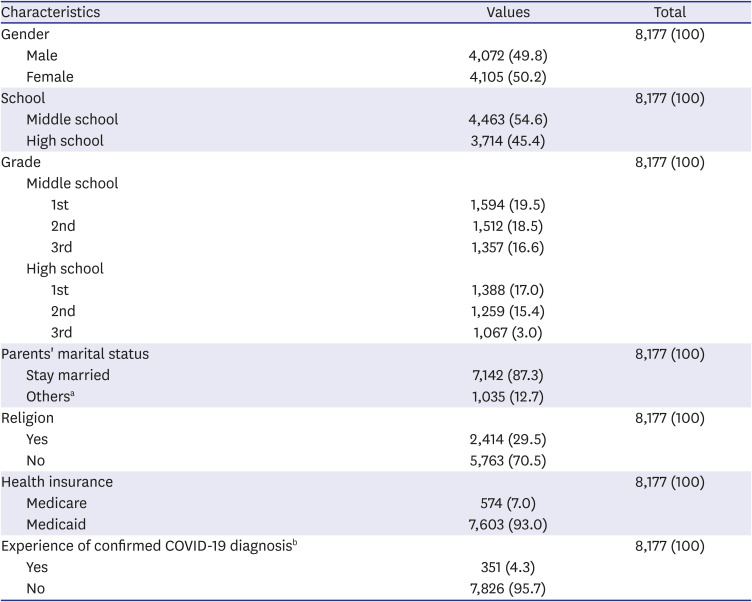
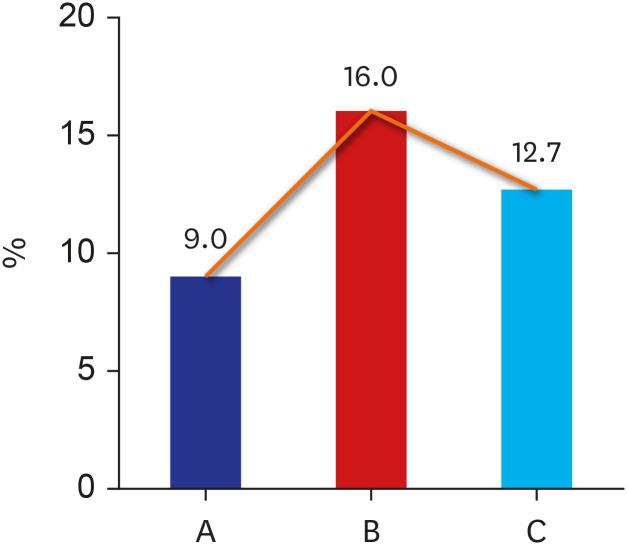
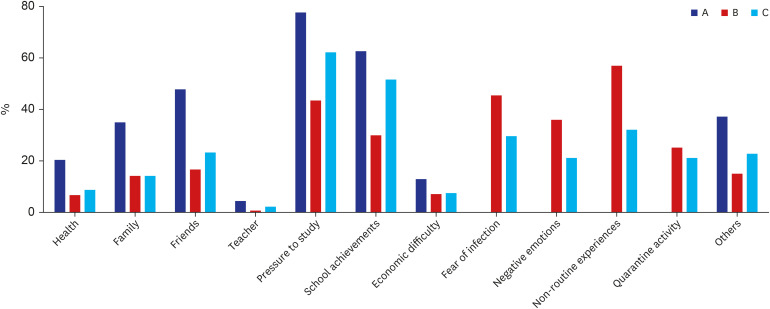
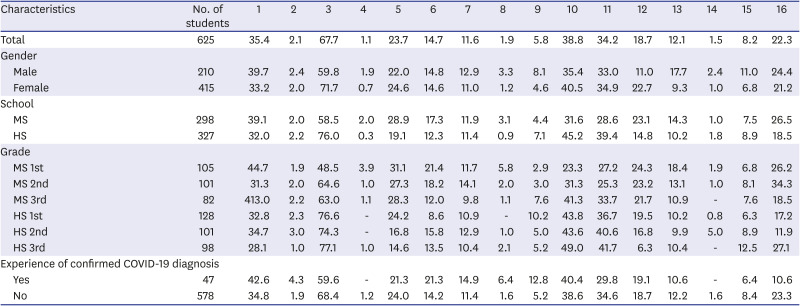
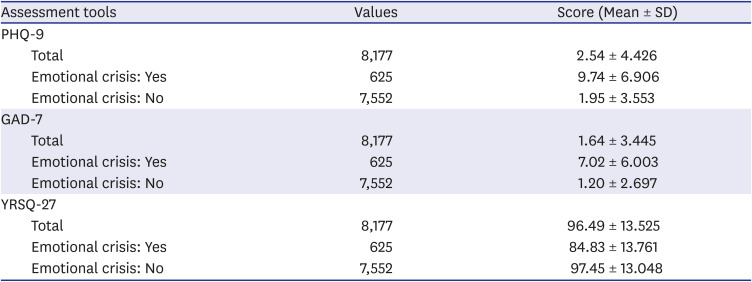
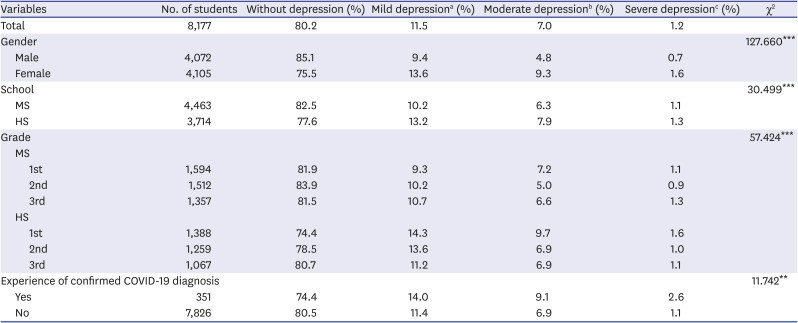
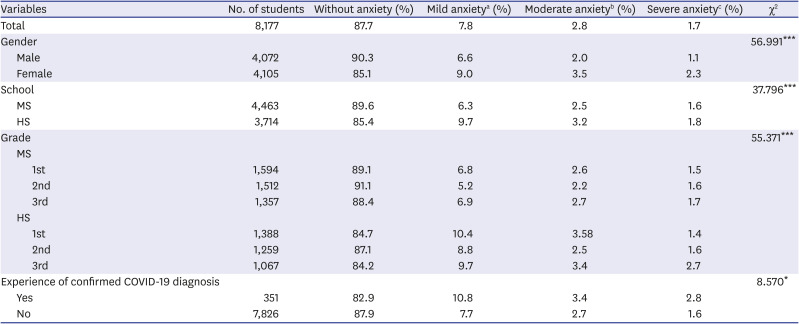
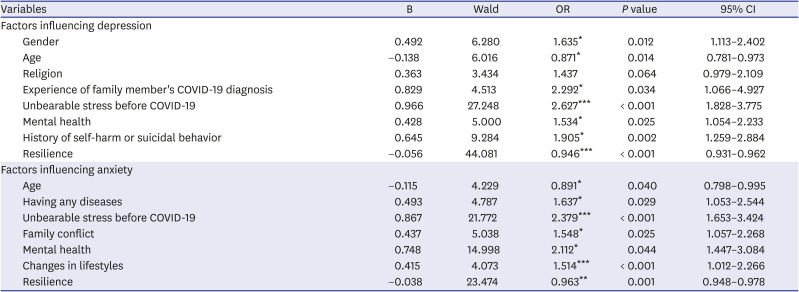




 PDF
PDF Citation
Citation Print
Print



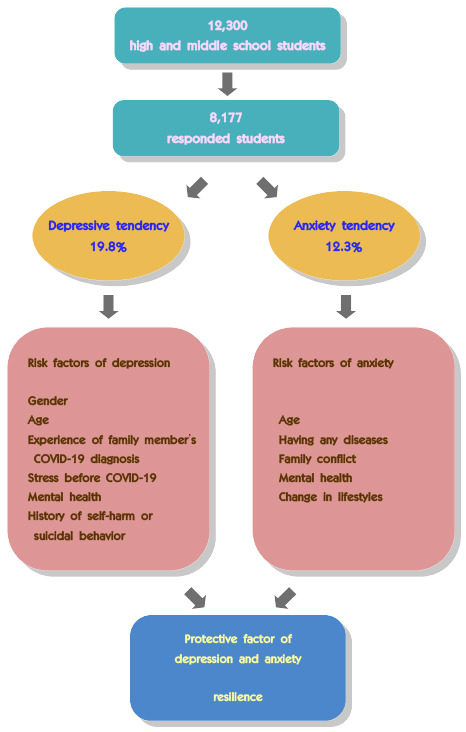
 XML Download
XML Download